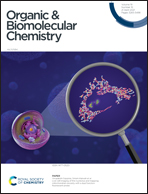Discovery of a highly efficient nitroaryl group for detection of nitroreductase and imaging of hypoxic tumor cells†
Abstract
Hypoxia is a pathological hallmark of solid tumors. Detection of hypoxia is therefore of great interest for tumor diagnosis and treatment. As a well-established biomarker of hypoxia, nitroreductase (NTR) has been widely exploited in the development of hypoxia-responsive fluorescent probes on the basis of its enzymatic activity to reduce nitroaryl groups. However, studies on the relationship between the nitroaryl structure and the probe performance for optimal probe design are still rare. Here we report a comparative investigation of nitroaryl groups and identification of the optimal nitroaryl structure for developing new fluorescent probes with extremely high efficiency in the detection of NTR and the imaging of hypoxic tumor cells. Specifically, we synthesized a series of resorufin-based fluorescent probes containing different nitroaryl groups, compared their fluorescence responses to NTR, and identified 2-nitro-N-methyl-imidazolyl as the optimal nitroaryl group that is much more efficient than the most widely used 4-nitrophenyl for NTR detection. The structure–performance relationship was then studied by theoretical molecular docking, revealing the unique features of 2-nitro-N-methyl-imidazolyl in binding and reaction with NTR. We further incorporated the 2-nitro-N-methyl-imidazolyl group into a near-infrared (NIR) hemicyanine fluorophore and developed a NIR fluorescent probe NFP-7 for the detection of NTR and hypoxic tumor cells. NFP-7 exhibits a strong fluorescence increase toward NTR in vitro with an ultrafast (within 40 seconds to fluorescence maximum) and ultrasensitive (0.2 ng mL−1 detection limit) response. NFP-7 has also been demonstrated for imaging the degree of hypoxia in live tumor cells and, more importantly, in a murine tumor model. Our study provides important insights into hypoxia probe development and new tools for hypoxia imaging.

- This article is part of the themed collection: Chemical Biology in OBC


 Please wait while we load your content...
Please wait while we load your content...